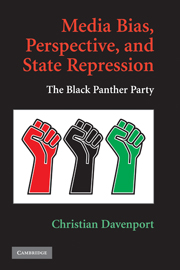Book contents
- Frontmatter
- Contents
- Figures and Tables
- Preface and Acknowledgments
- Media Bias, Perspective, and State Repression
- INTRODUCTION
- Part I Conceptualization
- 1 OBJECTIVITY AND SUBJECTIVITY IN EVENT CATALOGS
- 2 THE RASHOMON EFFECT, OBSERVATION, AND DATA GENERATION
- 3 UNDERSTANDING STATE REPRESSIVE BEHAVIOR
- Part II Cases
- Part III Conclusion
- Appendix: The Black Panther–U.S. Government Event Catalog
- Bibliography
- Index
2 - THE RASHOMON EFFECT, OBSERVATION, AND DATA GENERATION
Published online by Cambridge University Press: 05 June 2012
- Frontmatter
- Contents
- Figures and Tables
- Preface and Acknowledgments
- Media Bias, Perspective, and State Repression
- INTRODUCTION
- Part I Conceptualization
- 1 OBJECTIVITY AND SUBJECTIVITY IN EVENT CATALOGS
- 2 THE RASHOMON EFFECT, OBSERVATION, AND DATA GENERATION
- 3 UNDERSTANDING STATE REPRESSIVE BEHAVIOR
- Part II Cases
- Part III Conclusion
- Appendix: The Black Panther–U.S. Government Event Catalog
- Bibliography
- Index
Summary
[C]onfrontations involving [contentious politics] almost always lead to the construction of interpretations of them by authorities, media, politicians, and political activists.…Where, then, can [those] interested in questions of [contentious politics] place [themselves] in relation to these constructions? One possible posture is to seek to expose the falsifications contained in all of them. However, if one starts with the premise that [contention] in which innocent persons are harmed and killed is an evil, such a rhetorical strategy provides a poor vantage point. One must, therefore, take a stand in relation to the whole process of construction and contextualization.
Paul Brass, Theft of an Idol: Text and Context in the Representation of Collective Violence (1997)In Akira Kurosawa's film Rashomon a woodcutter, a priest, and a commoner take shelter from a torrential thunderstorm. While waiting for the rain to stop, the woodcutter and priest tell the commoner of a recent event involving a samurai, his wife, and a bandit. As the woodcutter and the priest tell their respective tales, the commoner (and audience) learns that at some point the wife and bandit had sex and later the husband was killed. The two explain that during the testimony given to the court about these events, the specifics of the attack were repeatedly called into question as the protagonists related their overlapping but conflicting versions of what took place.
- Type
- Chapter
- Information
- Media Bias, Perspective, and State RepressionThe Black Panther Party, pp. 52 - 73Publisher: Cambridge University PressPrint publication year: 2009



